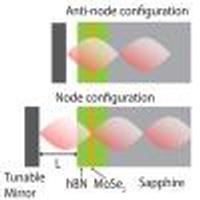Our official English website, www.x-mol.net, welcomes your feedback! (Note: you will need to create a separate account there.)
Engineering radiative coupling of excitons in 2D semiconductors
Optica ( IF 10.4 ) Pub Date : 2019-11-19 , DOI: 10.1364/optica.6.001443 Jason Horng , Yu-Hsun Chou , Tsu-Chi Chang , Chu-Yuan Hsu , Tien-Chang Lu , Hui Deng
Optica ( IF 10.4 ) Pub Date : 2019-11-19 , DOI: 10.1364/optica.6.001443 Jason Horng , Yu-Hsun Chou , Tsu-Chi Chang , Chu-Yuan Hsu , Tien-Chang Lu , Hui Deng

|
The resonance energy and the transition rate of atoms, molecules, and solids were understood as their intrinsic properties in classical electromagnetism. It was later realized that these quantities are linked to the radiative coupling between the transition dipole and photon modes. Such effects can be greatly amplified in macroscopic many-body systems from virtual photon exchange between dipoles, but are often masked by inhomogeneity and pure dephasing, especially in solids. Here, we observe in both absorption and emission spectroscopy the renormalization of the exciton resonance and the radiative decay rate in transition metal dichalcogenides monolayers due to their radiative interactions. Tuning the photon mode density near the monolayer, we demonstrate control of cooperative Lamb shift, radiative decay, and valley polarization of the excitons as well as control of the charged exciton emission. Our work establishes a technologically accessible and robust experimental system for engineering cooperative matter–light interactions.
中文翻译:

二维半导体中激子的工程辐射耦合
原子,分子和固体的共振能和跃迁速率被理解为经典电磁学中的固有特性。后来意识到,这些量与跃迁偶极子和光子模式之间的辐射耦合有关。在宏观多体系统中,偶极子之间的虚拟光子交换会大大放大此类效应,但通常会被不均匀性和纯相移所掩盖,尤其是在固体中。在这里,我们在吸收光谱和发射光谱中都观察到过渡金属二卤化物单分子层中由于其辐射相互作用而引起的激子共振和辐射衰变速率的重新归一化。调整单层附近的光子模式密度,我们演示了协同Lamb位移,辐射衰减,激子的谷极化和谷底极化以及带电激子发射的控制。我们的工作建立了一个技术上可访问且功能强大的实验系统,用于工程合作的物质-光相互作用。
更新日期:2019-11-21
中文翻译:

二维半导体中激子的工程辐射耦合
原子,分子和固体的共振能和跃迁速率被理解为经典电磁学中的固有特性。后来意识到,这些量与跃迁偶极子和光子模式之间的辐射耦合有关。在宏观多体系统中,偶极子之间的虚拟光子交换会大大放大此类效应,但通常会被不均匀性和纯相移所掩盖,尤其是在固体中。在这里,我们在吸收光谱和发射光谱中都观察到过渡金属二卤化物单分子层中由于其辐射相互作用而引起的激子共振和辐射衰变速率的重新归一化。调整单层附近的光子模式密度,我们演示了协同Lamb位移,辐射衰减,激子的谷极化和谷底极化以及带电激子发射的控制。我们的工作建立了一个技术上可访问且功能强大的实验系统,用于工程合作的物质-光相互作用。



























 京公网安备 11010802027423号
京公网安备 11010802027423号